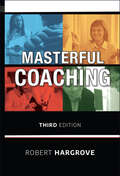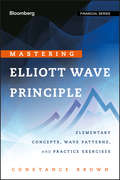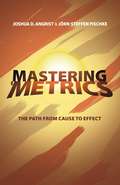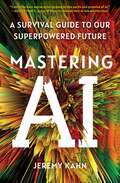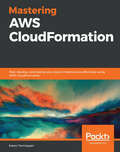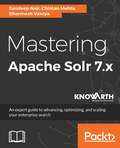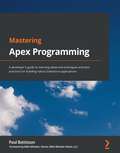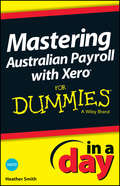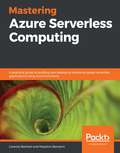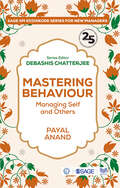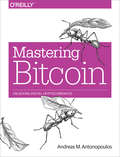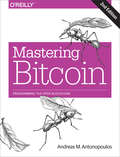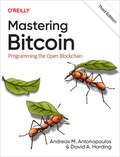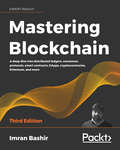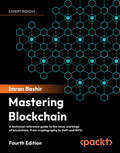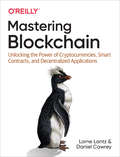- Table View
- List View
MasterCard International: World Championship Soccer Sponsorship
by David Lane David J. ArnoldMasterCard must decide whether to renew the sponsorship of the World Cup and other soccer events in light of a 100% increase in the sponsorship fee and a strategic realignment by MasterCard. A rewritten version of an earlier case.
MasterCard: Driving Financial Inclusion
by Natalie Kindred Rajiv Lal Sunil GuptaMasterCard CEO Ajay Banga was investing significant time and attention to increase financial inclusion among individuals with historically no access to banking or financial services in countries around the world with large underserved populations. The effort included partnerships with governments and banks to issue MasterCard branded debit cards to millions of individuals. Financial inclusion could potentially help these individuals by increasing financial literacy, building credit records, improving savings rates, providing access to loans and other financial products, and, in general, by increasing the economic opportunities for these newly banked consumers. And by adding more customers, MasterCard potentially could also grow its bottom line. Financial inclusion raised questions for MasterCard. Was the management time and attention well spent given the low returns expected from adding millions of mostly very poor customers? What risks might MasterCard encounter-particularly in some countries where citizens resented their government partnering with and providing personal data to a large U.S. company.
MasterCard: Driving Financial Inclusion
by Natalie Kindred Rajiv Lal Sunil GuptaMasterCard CEO Ajay Banga was investing significant time and attention to increase financial inclusion among individuals with historically no access to banking or financial services in countries around the world with large underserved populations. The effort included partnerships with governments and banks to issue MasterCard branded debit cards to millions of individuals. Financial inclusion could potentially help these individuals by increasing financial literacy, building credit records, improving savings rates, providing access to loans and other financial products, and, in general, by increasing the economic opportunities for these newly banked consumers. And by adding more customers, MasterCard potentially could also grow its bottom line. Financial inclusion raised questions for MasterCard. Was the management time and attention well spent given the low returns expected from adding millions of mostly very poor customers? What risks might MasterCard encounter-particularly in some countries where citizens resented their government partnering with and providing personal data to a large U.S. company.
Mastercard Labs (A)
by Linda A. Hill Sunil Gupta Julia Kelley Emily TedardsWhen Ajaypal (Ajay) Banga became the CEO of Mastercard in 2010, he shifted the company's competitive focus from card networks to cash itself. Mastercard's new vision of a "World Beyond Cash" distilled into a three-pronged framework: Grow the core business, Diversify customers and employees, and Build new businesses that reinforce Mastercard's core capabilities. With digital technologies on the rise, Banga knew that innovation would need to become a strategic imperative. Yet, in a 2010 survey, Mastercard's 7,000 employees ranked "innovation" as the 26th most important factor for the future of Mastercard in a list of 27. Banga tasked Garry Lyons, who had joined Mastercard through the 2009 acquisition of Orbiscom, with infusing innovation into Mastercard's culture. With a significant incremental investment, and free reign to spend it as he pleased, Lyons created Mastercard Labs-a global R&D network that became a catalytic force for change at the company. In December 2017, Lyons is stepping down from his role as Chief Innovation Officer and reflecting on the path ahead for Mastercard and its Labs.
Mastercard Labs (A) (Abridged)
by Linda A. Hill Sunil Gupta Julia Kelley Emily TedardsWhen Ajaypal (Ajay) Banga became the CEO of Mastercard in 2010, he shifted the company's competitive focus from card networks to cash itself. Mastercard's new vision of a "World Beyond Cash" distilled into a three-pronged framework: Grow the core business, Diversify customers and employees, and Build new businesses that reinforce Mastercard's core capabilities. With digital technologies on the rise, Banga knew that innovation would need to become a strategic imperative. Yet, in a 2010 survey, Mastercard's 7,000 employees ranked "innovation" as the 26th most important factor for the future of Mastercard in a list of 27. Banga tasked Garry Lyons, who had joined Mastercard through the 2009 acquisition of Orbiscom, with infusing innovation into Mastercard's culture. With a significant incremental investment, and free reign to spend it as he pleased, Lyons created Mastercard Labs-a global R&D network that became a catalytic force for change at the company. In December 2017, Lyons is stepping down from his role as Chief Innovation Officer and reflecting on the path ahead for Mastercard and its Labs.
Mastercard Labs (B)
by Linda A. Hill Sunil Gupta Julia Kelley Emily TedardsWhen Ajaypal (Ajay) Banga became the CEO of Mastercard in 2010, digital technologies were on the rise, and innovation needed to become a strategic imperative at the company. Banga tasked Garry Lyons, who had joined Mastercard through the 2009 acquisition of Orbiscom, with infusing innovation into Mastercard's culture. With a significant incremental investment, and free reign to spend it as he pleased, Lyons created Mastercard Labs-a global innovation lab network that became a catalytic force for change at the company. In 2018, Ken Moore, a former innovation leader at Citigroup, became Mastercard Labs' new leader. By then, Mastercard had made significant progress on its journey of cultural and digital transformation, but the company had to continue to think and act differently in order to compete and thrive in the fast-changing digital world. Moore's task was to evolve Mastercard Labs so that it could continue delivering value to Mastercard.
Mastercard: Creating a World Beyond Cash
by Linda A. Hill Sunil Gupta Julia Kelley Emily TedardsIn late 2021, Mastercard CEO Michael Miebach and Chairman and former CEO Ajaypal "Ajay" Banga considered how Mastercard could best position itself for continued success in the years to come. Since Mastercard's initial public offering in 2006, the company had grown and transformed, driven in part by a core strategy of "Grow-Diversify-Build" and vision of a "World Beyond Cash." During Banga's recent tenure as CEO, Mastercard had invested in creating a strong culture, recruiting top talent, driving innovation, partnering with would-be competitors, and launching new services. Now, with Miebach at the helm as Mastercard's CEO, the payments landscape was experiencing increasing democratization of the banking system, the rise of blockchain and cryptocurrency, and increasing nationalism, among other shifts. Miebach and Banga needed to identify the most pressing threats and opportunities in the ever-evolving payments landscape and determine how to take advantage of them. As they looked ahead, they asked themselves: Was Mastercard well positioned for the next 10 years?
Masterclass Enterprise Architecture Management
by Jürgen Jung Bardo FraunholzThis textbook provides a hands-on introduction to enterprise architecture management. It guides the reader through the applications of methods and tools to typical business problems by presenting enterprise architecture frameworks and by sharing experiences from industry.The structure of the book represents the typical stages of the journey of an enterprise architect. Chapter 1 addresses the central question of what to achieve with the introduction of an enterprise architecture. Chapter 2 then introduces concepts and visualizations for business architecture that help with understanding the business. In chapter 3 the development of an application architecture is outlined, which provides transparency on information systems and their business context. Next, chapter 4 presents visual tools to analyze, improve and eventually optimize the application landscape. Chapter 5 discusses both traditional organizational as well as collaborative approaches to enterprise architecture management. Eventually, several established enterprise architecture frameworks like TOGAF, Zachmann, ArchiMate, and IAF are described in chapter 6. The book concludes with a summary and an outlook on future research potential in chapter 7. Based on their experiences through several years of teaching, the authors introduce students step-by-step to enterprise architecture development and management. Their book is intended as a guide for master classes at universities and includes lots of exercises and references for further reading.
Masterful Coaching
by Robert HargroveWhen the first edition of Masterful Coaching was published, it quickly became the standard resource for anyone who was a coach, considering becoming a coach, or curious about being an extraordinary coach. In this completely revised third edition of his groundbreaking book, Hargrove presents his profound insights into the journey to of becoming a masterful coach along with guiding ideas, tools, and methods.
Mastering
by Tim Jackson David ShawThe first academic textbook covering European retail fashion buying and merchandising. It provides a unique insight into best practice across the fashion industry.
Mastering Elliott Wave Principle
by Constance BrownAn innovative approach to applying Elliott Wave PrincipleBy convention, most Elliott Wave Principle (EWP) practitioners focus on individual market price movement. Connie Brown has a global reputation of developing analysis that focuses on the integration of global markets. In a two book series you will be taken through the steps to master the global cash flows of today's financial markets. The approach found in this first book differs from the traditional view of EWP because it shows you how geometry and the use of simple boxes drawn within a trend will guide you away from the common complaint of subjectivity, thereby making smarter trades of higher probability. While EWP can be a challenging topic, the structure of this book eases you into the analysis principles.With Mastering Elliott Wave Principle you are guided step-by-step through the learning phases of Elliott Wave analysis and then your understanding is further challenged through self-examination. The preliminary coaching unravels common misunderstandings that sabotage the beginner. You will discover how price swings and waves are not the same. Elements of balance and proportion are mathematical concepts taught through geometry and not subjective. These basic skills establish a foundation that allow beginners to understand what to expect from their level of skill. There are three distinct levels of skill that all masters of the EWP have learned. Now there is a series to guide your understanding at each skill level so you can develop a working knowledge of how to define market positions around the world in short or long term time horizons. Bring your biases, bring your past concerns and discover how this breakthrough and original approach to teaching the Wave Principle can help you.Traders, from beginners to advanced, can use this book to become proficient in the Elliott Wave PrincipleContains practice charts to compare your understanding and skill level with follow-up discussions of how you may have differed based on the results from twenty years of coaching
Mastering 'Metrics: The Path from Cause to Effect
by Joshua D. Angrist Jörn-Steffen PischkeFrom Joshua Angrist, winner of the Nobel Prize in Economics, and Jörn-Steffen Pischke, an accessible and fun guide to the essential tools of econometric researchApplied econometrics, known to aficionados as 'metrics, is the original data science. 'Metrics encompasses the statistical methods economists use to untangle cause and effect in human affairs. Through accessible discussion and with a dose of kung fu–themed humor, Mastering 'Metrics presents the essential tools of econometric research and demonstrates why econometrics is exciting and useful.The five most valuable econometric methods, or what the authors call the Furious Five—random assignment, regression, instrumental variables, regression discontinuity designs, and differences in differences—are illustrated through well-crafted real-world examples (vetted for awesomeness by Kung Fu Panda's Jade Palace). Does health insurance make you healthier? Randomized experiments provide answers. Are expensive private colleges and selective public high schools better than more pedestrian institutions? Regression analysis and a regression discontinuity design reveal the surprising truth. When private banks teeter, and depositors take their money and run, should central banks step in to save them? Differences-in-differences analysis of a Depression-era banking crisis offers a response. Could arresting O. J. Simpson have saved his ex-wife's life? Instrumental variables methods instruct law enforcement authorities in how best to respond to domestic abuse.Wielding econometric tools with skill and confidence, Mastering 'Metrics uses data and statistics to illuminate the path from cause to effect.Shows why econometrics is importantExplains econometric research through humorous and accessible discussionOutlines empirical methods central to modern econometric practiceWorks through interesting and relevant real-world examples
Mastering AI: A Survival Guide to Our Superpowered Future
by Jeremy KahnA Fortune magazine journalist draws on his expertise and extensive contacts among the companies and scientists at the forefront of artificial intelligence to offer dramatic predictions of AI&’s impact over the next decade, from reshaping our economy and the way we work, learn, and create to unknitting our social fabric, jeopardizing our democracy, and fundamentally altering the way we think.Within the next five years, Jeremy Kahn predicts, AI will disrupt almost every industry and enterprise, with vastly increased efficiency and productivity. It will restructure the workforce, making AI copilots a must for every knowledge worker. It will revamp education, meaning children around the world can have personal, portable tutors. It will revolutionize health care, making individualized, targeted pharmaceuticals more affordable. It will compel us to reimagine how we make art, compose music, and write and publish books. The potential of generative AI to extend our skills, talents, and creativity as humans is undeniably exciting and promising. But while this new technology has a bright future, it also casts a dark and fearful shadow. AI will provoke pervasive, disruptive, potentially devastating knock-on effects. Leveraging his unrivaled access to the leaders, scientists, futurists, and others who are making AI a reality, Kahn will argue that if not carefully designed and vigilantly regulated AI will deepen income inequality, depressing wages while imposing winner-take-all markets across much of the economy. AI risks undermining democracy, as truth is overtaken by misinformation, racial bias, and harmful stereotypes. Continuing a process begun by the internet, AI will rewire our brains, likely inhibiting our ability to think critically, to remember, and even to get along with one another—unless we all take decisive action to prevent this from happening. Much as Michael Lewis&’s classic The New New Thing offered a prescient, insightful, and eminently readable account of life inside the dot-com bubble, Mastering AI delivers much-needed guidance for anyone eager to understand the AI boom—and what comes next.
Mastering AWS CloudFormation: Plan, develop, and deploy your cloud infrastructure effectively using AWS CloudFormation
by Karen TovmasyanBuild scalable and production-ready infrastructure in Amazon Web Services with CloudFormation Key Features Leverage AWS CloudFormation templates to manage your entire infrastructure Get up and running with writing your infrastructure as code and automating your environment Simplify infrastructure management and increase productivity with AWS CloudFormation Book Description DevOps and the cloud revolution have forced software engineers and operations teams to rethink how to manage infrastructures. With this AWS book, you'll understand how you can use Infrastructure as Code (IaC) to simplify IT operations and manage the modern cloud infrastructure effectively with AWS CloudFormation. This comprehensive guide will help you explore AWS CloudFormation from template structures through to developing complex and reusable infrastructure stacks. You'll then delve into validating templates, deploying stacks, and handling deployment failures. The book will also show you how to leverage AWS CodeBuild and CodePipeline to automate resource delivery and apply continuous integration and continuous delivery (CI/CD) practices to the stack. As you advance, you'll learn how to generate templates on the fly using macros and create resources outside AWS with custom resources. Finally, you'll improve the way you manage the modern cloud in AWS by extending CloudFormation using AWS serverless application model (SAM) and AWS cloud development kit (CDK). By the end of this book, you'll have mastered all the major AWS CloudFormation concepts and be able to simplify infrastructure management. What you will learn Understand modern approaches to IaC Develop universal and reusable CloudFormation templates Discover ways to apply continuous delivery with CloudFormation Implement IaC best practices for the AWS Cloud Provision massive applications across multiple regions and accounts Automate template generation and software provisioning for AWS Extend CloudFormation with custom resources and template macros Who this book is for If you are a developer who wants to learn how to write templates, a DevOps engineer interested in deployment and orchestration, or a solutions architect looking to understand the benefits of managing infrastructure with ease, this book is for you. Prior understanding of the AWS Cloud is necessary.
Mastering Apache Solr 7.x: An expert guide to advancing, optimizing, and scaling your enterprise search
by Sandeep Nair Chintan Mehta Dharmesh VasoyaAccelerate your enterprise search engine and bring relevancy in your search analytics Key Features A practical guide in building expertise with Indexing, Faceting, Clustering and Pagination Master the management and administration of Enterprise Search Applications and services seamlessly Handle multiple data inputs such as JSON, xml, pdf, doc, xls,ppt, csv and much more. Book Description Apache Solr is the only standalone enterprise search server with a REST-like application interface. providing highly scalable, distributed search and index replication for many of the world's largest internet sites. To begin with, you would be introduced to how you perform full text search, multiple filter search, perform dynamic clustering and so on helping you to brush up the basics of Apache Solr. You will also explore the new features and advanced options released in Apache Solr 7.x which will get you numerous performance aspects and making data investigation simpler, easier and powerful. You will learn to build complex queries, extensive filters and how are they compiled in your system to bring relevance in your search tools. You will learn to carry out Solr scoring, elements affecting the document score and how you can optimize or tune the score for the application at hand. You will learn to extract features of documents, writing complex queries in re-ranking the documents. You will also learn advanced options helping you to know what content is indexed and how the extracted content is indexed. Throughout the book, you would go through complex problems with solutions along with varied approaches to tackle your business needs. By the end of this book, you will gain advanced proficiency to build out-of-box smart search solutions for your enterprise demands. What you will learn Design schema using schema API to access data in the database Advance querying and fine-tuning techniques for better performance Get to grips with indexing using Client API Set up a fault tolerant and highly available server with newer distributed capabilities, SolrCloud Explore Apache Tika to upload data with Solr Cell Understand different data operations that can be done while indexing Master advanced querying through Velocity Search UI, faceting and Query Re-ranking, pagination and spatial search Learn to use JavaScript, Python, SolrJ and Ruby for interacting with Solr Who this book is for The book would rightly appeal to developers, software engineers, data engineers and database architects who are building or seeking to build enterprise-wide effective search engines for business intelligence. Prior experience of Apache Solr or Java programming is must to take the best of this book.
Mastering Apex Programming: A developer's guide to learning advanced techniques and best practices for building robust Salesforce applications
by Paul BattissonThis book is for Salesforce developers who are interested in mastering Apex programming skills. You’ll also find this book helpful if you’re an experienced Java or C# developer looking to switch to Apex programming for developing apps on the Salesforce platform. Basic Apex programming knowledge will assist with understanding the concepts covered.
Mastering Australian Payroll with Xero In A Day For Dummies
by Heather SmithIf you’ve been using the cloud-based Xero system and running an existing payroll outside of Xero, or you’re looking to employ people for your small business in Australia, then this In A Day book is the resource you need. This book navigates through the payroll basics, and explains how to define payroll settings and set up employees. Mastering Australian Payroll with Xero In A Day For Dummies shows you how to define employee pay template settings, and helps you master some of the more advanced payroll functions in Xero. Employment expense is a significant chunk of outgoings for many businesses, so you want to make sure that you’ve covered all your bases, and that you’re meeting all of the relevant Australian compliance obligations. With this resource handy, you’ll be confidently processing payroll in Xero in no time — in fact, you’ll be there in just one day!
Mastering Azure Serverless Computing: A practical guide to building and deploying enterprise-grade serverless applications using Azure Functions
by Lorenzo Barbieri Massimo BonanniBecome an expert in implementing Azure Functions to work seamlessly with your serverless applications Key Features Develop scalable, robust multi-tier apps without worrying about infrastructure needs Deploy and manage cost-effective and highly available serverless apps using Azure Functions Accelerate enterprise-level application development by seamlessly integrating different cloud services with Azure Functions Book Description Application development has evolved from traditional monolithic app development to using serverless options and microservices. This book is designed to guide you through using Microsoft's Azure Functions to process data, integrate systems, and build simple APIs and microservices. You will discover how to apply serverless computing to speed up deployment and reduce downtime. You'll also explore Azure Functions, including its core functionalities and essential tools, along with understanding how to debug and even customize Azure Functions. In addition to this, the book will take you through how you can effectively implement DevOps and automation in your working environment. Toward the concluding chapters, you'll cover some quick tips, troubleshooting techniques, and real-world serverless use cases that will help you make the most of serverless computing. By the end of this book, you will have gained the skills you need to develop and deliver cost-effective Azure serverless solutions. What you will learn Create and deploy advanced Azure Functions Learn to extend the runtime of Azure Functions Orchestrate your logic through code or a visual workflow Add caching, security, routing, and filtering to your APIs Use serverless technologies in real-world scenarios Understand how to apply DevOps and automation to your working environment Who this book is for This book is designed for cloud administrators, architects, and developers interested in building scalable systems and deploying serverless applications with Azure Functions. Prior knowledge of core Microsoft Azure services and Azure Functions is necessary to understand the topics covered in this book.
Mastering Behaviour: Managing Self and Others (SAGE IIM Kozhikode Series for New Managers)
by Payal AnandA new workplace demands that you take charge of your anchors. It challenges you to pay attention to the aspects that drive your behaviour, attitudes, perceptions, and emotions. At the same time, recognizing the motives, needs and emotions of others is imperative for personal leadership. This will help you hone your collaborative instincts, and in embracing diversity and engaging effectively in a professional setting. Based on the author’s experiences and her interaction with others, Mastering Behaviour explores the hinterland of behavioural insights. Applying popular psychology theories, the book helps in tackling difficult interpersonal and behavioural issues at work, such as personality clashes, stress, handling difficult interactions and workplace loneliness. With technological developments changing the way we connect, the book will provide insights to the real-world challenges of developing greater trust, engagement and collaboration within their teams and the organization.
Mastering Bitcoin
by Andreas M. AntonopoulosWant to join the technological revolution that's taking the world of finance by storm? Mastering Bitcoin is your guide through the seemingly complex world of bitcoin, providing the requisite knowledge to help you participate in the internet of money. Whether you're building the next killer app, investing in a startup, or simply curious about the technology, this practical book is essential reading.Bitcoin, the first successful decentralized digital currency, is still in its infancy and it's already spawned a multi-billion dollar global economy. This economy is open to anyone with the knowledge and passion to participate. Mastering Bitcoin provides you with the knowledge you need (passion not included).This book includes:A broad introduction to bitcoin--ideal for non-technical users, investors, and business executivesAn explanation of the technical foundations of bitcoin and cryptographic currencies for developers, engineers, and software and systems architectsDetails of the bitcoin decentralized network, peer-to-peer architecture, transaction lifecycle, and security principlesOffshoots of the bitcoin and blockchain inventions, including alternative chains, currencies, and applicationsUser stories, analogies, examples, and code snippets illustrating key technical concepts
Mastering Bitcoin: Programming the Open Blockchain
by Andreas M. AntonopoulosJoin the technological revolution that’s taking the financial world by storm. Mastering Bitcoin is your guide through the seemingly complex world of bitcoin, providing the knowledge you need to participate in the internet of money. Whether you’re building the next killer app, investing in a startup, or simply curious about the technology, this revised and expanded second edition provides essential detail to get you started.Bitcoin, the first successful decentralized digital currency, is still in its early stages and yet it’s already spawned a multi-billion-dollar global economy open to anyone with the knowledge and passion to participate. Mastering Bitcoin provides the knowledge. You simply supply the passion.The second edition includes:A broad introduction of bitcoin and its underlying blockchain—ideal for non-technical users, investors, and business executivesAn explanation of the technical foundations of bitcoin and cryptographic currencies for developers, engineers, and software and systems architectsDetails of the bitcoin decentralized network, peer-to-peer architecture, transaction lifecycle, and security principlesNew developments such as Segregated Witness, Payment Channels, and Lightning NetworkA deep dive into blockchain applications, including how to combine the building blocks offered by this platform into higher-level applicationsUser stories, analogies, examples, and code snippets illustrating key technical concepts
Mastering Bitcoin: Programming the Open Blockchain
by Andreas M. Antonopoulos David A. HardingJoin the technological revolution that's taking the financial world by storm. Mastering Bitcoin is your guide through the seemingly complex world of Bitcoin, providing the knowledge you need to participate in the internet of money. Whether you're building the next killer app, investing in a startup, or simply curious about the technology, this revised and expanded third edition provides essential detail to get you started. Bitcoin, the first successful decentralized digital currency, has already spawned a multibillion-dollar global economy open to anyone with the knowledge and passion to participate. Mastering Bitcoin provides the knowledge. You supply the passion.The third edition includes:A broad introduction to Bitcoin and its underlying blockchain—ideal for nontechnical users, investors, and business executivesAn explanation of Bitcoin's technical foundation and cryptographic currency for developers, engineers, and software and systems architectsDetails of the Bitcoin decentralized network, peer-to-peer architecture, transaction lifecycle, and security principlesNew developments such as Taproot, Tapscript, Schnorr signatures, and the Lightning NetworkA deep dive into Bitcoin applications, including how to combine the building blocks offered by this platform into powerful new toolsUser stories, analogies, examples, and code snippets illustrating key technical concepts
Mastering Blockchain: A deep dive into distributed ledgers, consensus protocols, smart contracts, DApps, cryptocurrencies, Ethereum, and more, 3rd Edition
by Imran BashirDevelop a deep understanding of the theoretical foundations of blockchain technology and learn how to write smart contracts and build decentralized applications Key Features Updated with four new chapters on consensus algorithms, Ethereum 2.0, tokenization, and enterprise blockchains Dive deep into foundational pillars of blockchain technology such as decentralization, cryptography, and consensus protocols Get to grips with Solidity, Web3, cryptocurrencies, smart contract development and solve scalability, security, and privacy issues Discover the architecture of different distributed ledger platforms including Ethereum, Bitcoin, Hyperledger Fabric, Hyperledger Sawtooth, Corda, and Quorum Book Description Blockchain technology is the backbone of cryptocurrencies, and it has applications in finance, government, media, and many other industries. With a legacy of providing technologists with executable insights, the third edition of Mastering Blockchain is thoroughly revised and updated with the latest blockchain research, including four new chapters on consensus algorithms, Serenity (Ethereum 2.0), tokenization, and enterprise blockchains. Apart from covering the basics, including blockchain's technical underpinnings, cryptography, and consensus protocols, this book provides you with expert knowledge on decentralization, decentralized application development on Ethereum, Bitcoin, alternative coins, smart contracts, alternative blockchains, and Hyperledger. Furthermore, you will explore how to implement blockchain solutions beyond cryptocurrencies, such as the Internet of Things with blockchain, blockchain scalability, enterprise blockchains, and tokenization using blockchain, and the future scope of this fascinating and disruptive technology. By the end of this book, you will have gained a thorough understanding of the various facets of blockchain technology and be comfortable applying them to diverse real-world scenarios. What you will learn Grasp the mechanisms behind Bitcoin, Ethereum, and alternative cryptocurrencies Understand cryptography and its usage in blockchain technology Understand the theoretical foundations of smart contracts Develop decentralized applications using Solidity, Remix, Truffle, Ganache, and Drizzle Identify and examine applications of blockchain beyond cryptocurrencies Understand the architecture and development of Ethereum 2.0 Explore research topics and the future scope of blockchain technology Who this book is for If you are a technologist, business executive, a student or an enthusiast who wishes to explore the fascinating world of blockchain technology, smart contracts, decentralized applications and distributed systems then this book is for you. Basic familiarity with a beginner-level command of a programming language would be a plus.
Mastering Blockchain: A technical reference guide to the inner workings of blockchain, from cryptography to DeFi and NFTs, 4th Edition
by Imran BashirDemystify one of the most disruptive modern technologies and gain an understanding of distributed ledger technology, consensus protocols, smart contracts, DApps, blockchain scalability, privacy, security, and more.Purchase of the print or Kindle book includes a free eBook in PDF format.Key FeaturesStudy new blockchains, including Polkadot, Solana, and dive into the architecture of Ethereum's execution and consensus layerExplore distributed ledger technologies such as Ethereum, Bitcoin, Hyperledger Fabric, and QuorumGet to grips with Solidity, Web3, NFTs, DeFi, and smart contract developmentBook DescriptionBlockchain is the backbone of cryptocurrencies, with applications in finance, government, media, and more. With a legacy of providing technologists with executable insights, this new edition of Mastering Blockchain is thoroughly revised and updated according to the latest blockchain research. With new chapters on decentralized finance, decentralized identity, blockchain privacy, scalability, security, and bonus online content exploring alternative blockchains, this is an unmissable read for everyone who wants to gain a deep understanding of blockchain.Although this book covers the basics, including blockchain's technical underpinnings, cryptography, and consensus protocols, it doesn't shy away from advanced topics and practical expertise, such as decentralized application (DApp) development using smart contracts. Throughout the book, you'll explore blockchain solutions beyond cryptocurrencies, such as the Internet of Things (IoT) with blockchain, enterprise blockchains, and tokenization, and gain insight into the future scope of this fascinating and disruptive technology.By the end of this blockchain book, you will have gained a thorough understanding of the various facets of blockchain and understand the potential of this technology in diverse real-world scenarios.What you will learnGrasp the mechanisms behind Bitcoin, Ethereum, and other blockchain protocolsUnderstand cryptography and its usage in blockchainBecome familiar with blockchain consensus algorithms and develop smart contracts and DApps using Solidity, Remix, Truffle, and GanacheSolve issues relating to scalability, privacy, and security in blockchainExplore enterprise blockchainsDelve into emerging trends like decentralized and self-sovereign identity, DeFi, NFTs, and MetaverseExplore various applications, research topics, and future directions of blockchainWho this book is forThis book is for blockchain enthusiasts from all backgrounds, including business executives who want to leverage new platforms and students who want to a textbook exploring this fascinating technology. It is also a useful reference guide for blockchain development professionals who want to build fast and highly secure transactional applications. Basic knowledge in any programming language will come in handy.
Mastering Blockchain: Unlocking The Power Of Cryptocurrencies, Smart Contracts, And Decentralized Applications
by Lorne Lantz Daniel CawreyThe future will be increasingly distributed. As the publicity surrounding Bitcoin and blockchain has shown, distributed technology and business models are gaining popularity. Yet the disruptive potential of this technology is often obscured by hype and misconception. This detailed guide distills the complex, fast moving ideas behind blockchain into an easily digestible reference manual, showing what's really going on under the hood.Finance and technology pros will learn how a blockchain works as they explore the evolution and current state of the technology, including the functions of cryptocurrencies and smart contracts. This book is for anyone evaluating whether to invest time in the cryptocurrency and blockchain industry. Go beyond buzzwords and see what the technology really has to offer.Learn why Bitcoin was fundamentally important in blockchain's birthLearn how Ethereum has created a fertile ground for new innovations like Decentralized Finance (DeFi), Non-Fungible Tokens (NFTs) and Flash LoansDiscover the secrets behind cryptocurrency prices and different forces that affect the highly volatile cryptocurrency marketsLearn how cryptocurrencies are used by criminals to carry out nefarious activitiesDiscover how enterprise and governments are leveraging the blockchain including FacebookUnderstand the challenges of scaling and forking a blockchainLearn how different blockchains workLearn the language of blockchain as industry terms are explained


